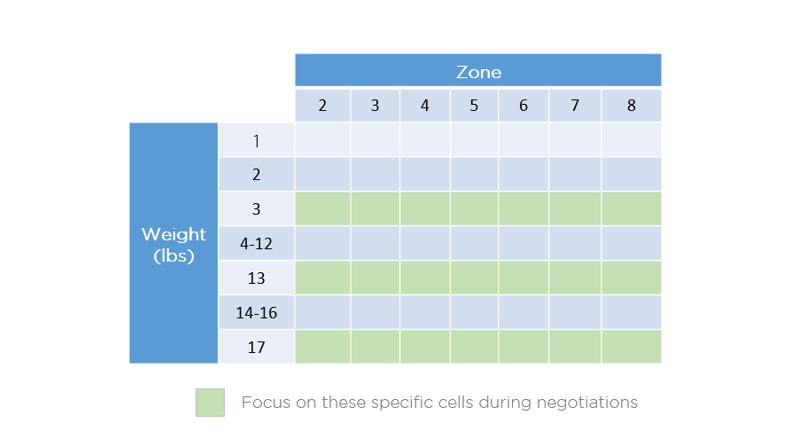In a previous article, I referenced business intelligence and its importance in managing small parcel supply chains. It wasn’t merely for the sake of audit and service recovery, but for the sake of driving real value to your organization through visibility and proactive management of properly-aligned KPIs. In that context, I touched on ground weight distribution and the impact of dimensional billing, but I left this rich concept largely unresolved because it was “a topic for another day.” Well, today is that day. And forgive the title of this article. I couldn’t resist. We should all give a DIM about this important topic.
DIM Billing Requires New Level Sophistication
As of 2015, ‘DIM billing’ has become a dirty word in the small parcel world. In fact, you’ve all heard me refer to 2015 as the mother of all rate increases. A lot of that is predicated on implementation of ground dimensional billing. Since then, carriers have continued to push the envelope in this arena.
The concept of paying for the space a package takes up in carrier assets has logic to it. However, increases to your small parcel supply chain become exorbitant when dimensional billing — and its inherent lack of visibility — is combined with annual GRIs and accessorial increases.
Although most of us understand the difficulty in mitigating DIM billing impact, let me ask a very basic question: how can you effectively mitigate the impact of DIM billing if you don’t understand or measure it today? The answer is, you can’t. You can certainly go to market and negotiate the DIM factor. More likely than not, you will find that carriers will placate you with a modified DIM billing factor, and they will step it down over time to bring you back to market. All the while, you may have a hazy perspective surrounding the impact to your bottom line.
By gaining visibility into your package characteristics, understanding how carriers view your shipments as well as understanding their associated yield management strategies, there are actionable insights to be gained that start you down the path to more effective DIM mitigation.
DIM Impact to Your Bottom Line
Imagine your distribution center. You have multiple SKUs, and your packaging solutions offer you five different box sizes. Through your BI platform, look at your package distribution and compare it to your five different box size dimensions. You can then compare what the DIM billed weight would be for each of those in comparison to your actual weight distribution. This provides you with the ability to change the DIM factor while gaining perspective on how that might shift your package characteristics within your rate card. In doing so, you gain perspective on the revenue impact of dimensional billing in your business, and you’re now one step closer to being more successful in negotiating with the carriers.
Alternative to Negotiating DIM Factor
Often times, I’ve found that there are more fruitful negotiating paths to head down with carriers than others. As previously stated, negotiating DIM factors can be difficult. Yet, if you’re armed with good data and you understand the current DIM factor in the marketplace and where your packages will be billed, could you potentially align a rate card that effectively mitigates the impact of the dimensional or billed weight?
Here’s a quick illustration of three box sizes showing actual weight vs billed DIM weight.

Rather than negotiating your DIM factor, negotiate your rate card for the billed (DIM) weight on those box sizes. In this example, you would focus on 3, 13 and 17-lb shipments for all zones to which you are shipping.

For many shippers, following this alternative path has offered a better long-term solution to DIM-billing than simply targeting the DIM factor. As previously stated, a modified DIM factor has a limited shelf life. The carrier will want to wean you off the DIM factor year-over-year. Constructing the right discount structure aligned with your billed weight characteristics will offer you a compounded value over the term of your contract.
In closing, I can’t stress enough the importance of using a robust BI platform and using it to your strongest advantage. As we continue to catch hints at a declining audit recovery market, the value you get out of your platform will be solely determined by how you use it to make informed decisions. If audit recovery is the focus of your current platform, it will be wise to begin exploring your options. Business intelligence is the future of intelligent supply chains.
Glenn Gooding is President of iDrive Logistics and the industry thought leader in carrier cost model methodologies and data analysis. He spent more than two decades at UPS, where he engineered the cost and pricing models for the world’s largest enterprise shippers. Glenn now leverages his expertise to help shippers better understand their shipping data in pursuit of shipping optimization and cost reduction. Glenn can be reached at glenn@idrivelogistics.com or 678.567.6847.


















